+ データを開く
データを開く
- 基本情報
基本情報
| 登録情報 | データベース: PDB / ID: 5uu5 | ||||||
|---|---|---|---|---|---|---|---|
| タイトル | Bacteriophage P22 mature virion capsid protein | ||||||
 要素 要素 | Major capsid protein | ||||||
 キーワード キーワード |  VIRUS (ウイルス) / P22 Bacteriophage VIRUS (ウイルス) / P22 Bacteriophage | ||||||
| 機能・相同性 | Major capsid protein Gp5 / P22 coat protein - gene protein 5 / viral procapsid / viral procapsid maturation / T=7 icosahedral viral capsid /  カプシド / identical protein binding / Major capsid protein カプシド / identical protein binding / Major capsid protein 機能・相同性情報 機能・相同性情報 | ||||||
| 生物種 |   Salmonella phage P22 (ファージ) Salmonella phage P22 (ファージ) | ||||||
| 手法 |  電子顕微鏡法 / 電子顕微鏡法 /  単粒子再構成法 / 単粒子再構成法 /  クライオ電子顕微鏡法 / 解像度: 3.3 Å クライオ電子顕微鏡法 / 解像度: 3.3 Å | ||||||
 データ登録者 データ登録者 | Hryc, C.F. / Chen, D.-H. / Afonine, P.V. / Jakana, J. / Wang, Z. / Haase-Pettingell, C. / Jiang, W. / Adams, P.D. / King, J.A. / Schmid, M.F. / Chiu, W. | ||||||
 引用 引用 |  ジャーナル: Proc Natl Acad Sci U S A / 年: 2017 ジャーナル: Proc Natl Acad Sci U S A / 年: 2017タイトル: Accurate model annotation of a near-atomic resolution cryo-EM map. 著者: Corey F Hryc / Dong-Hua Chen / Pavel V Afonine / Joanita Jakana / Zhao Wang / Cameron Haase-Pettingell / Wen Jiang / Paul D Adams / Jonathan A King / Michael F Schmid / Wah Chiu /  要旨: Electron cryomicroscopy (cryo-EM) has been used to determine the atomic coordinates (models) from density maps of biological assemblies. These models can be assessed by their overall fit to the ...Electron cryomicroscopy (cryo-EM) has been used to determine the atomic coordinates (models) from density maps of biological assemblies. These models can be assessed by their overall fit to the experimental data and stereochemical information. However, these models do not annotate the actual density values of the atoms nor their positional uncertainty. Here, we introduce a computational procedure to derive an atomic model from a cryo-EM map with annotated metadata. The accuracy of such a model is validated by a faithful replication of the experimental cryo-EM map computed using the coordinates and associated metadata. The functional interpretation of any structural features in the model and its utilization for future studies can be made in the context of its measure of uncertainty. We applied this protocol to the 3.3-Å map of the mature P22 bacteriophage capsid, a large and complex macromolecular assembly. With this protocol, we identify and annotate previously undescribed molecular interactions between capsid subunits that are crucial to maintain stability in the absence of cementing proteins or cross-linking, as occur in other bacteriophages. | ||||||
| 履歴 |
|
- 構造の表示
構造の表示
| ムービー |
 ムービービューア ムービービューア |
|---|---|
| 構造ビューア | 分子:  Molmil Molmil Jmol/JSmol Jmol/JSmol |
- ダウンロードとリンク
ダウンロードとリンク
- ダウンロード
ダウンロード
| PDBx/mmCIF形式 |  5uu5.cif.gz 5uu5.cif.gz | 560 KB | 表示 |  PDBx/mmCIF形式 PDBx/mmCIF形式 |
|---|---|---|---|---|
| PDB形式 |  pdb5uu5.ent.gz pdb5uu5.ent.gz | 468.5 KB | 表示 |  PDB形式 PDB形式 |
| PDBx/mmJSON形式 |  5uu5.json.gz 5uu5.json.gz | ツリー表示 |  PDBx/mmJSON形式 PDBx/mmJSON形式 | |
| その他 |  その他のダウンロード その他のダウンロード |
-検証レポート
| アーカイブディレクトリ |  https://data.pdbj.org/pub/pdb/validation_reports/uu/5uu5 https://data.pdbj.org/pub/pdb/validation_reports/uu/5uu5 ftp://data.pdbj.org/pub/pdb/validation_reports/uu/5uu5 ftp://data.pdbj.org/pub/pdb/validation_reports/uu/5uu5 | HTTPS FTP |
|---|
-関連構造データ
| 関連構造データ |  8606MC M: このデータのモデリングに利用したマップデータ C: 同じ文献を引用 ( |
|---|---|
| 類似構造データ | |
| 電子顕微鏡画像生データ |  EMPIAR-10083 (タイトル: Bacteriophage P22 mature virion capsid protein EMPIAR-10083 (タイトル: Bacteriophage P22 mature virion capsid proteinData size: 159.4 Data #1: Corrected images of P22 Mature Phage [picked particles - multiframe - processed]) |
- リンク
リンク
- 集合体
集合体
| 登録構造単位 | 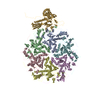
|
|---|---|
| 1 | x 60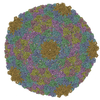
|
| 2 |
|
| 3 | x 5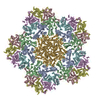
|
| 4 | x 6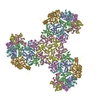
|
| 5 | 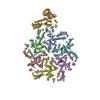
|
| 対称性 | 点対称性: (シェーンフリース記号 : I (正20面体型対称 : I (正20面体型対称 )) )) |
- 要素
要素
| #1: タンパク質 | 分子量: 46795.613 Da / 分子数: 7 / 由来タイプ: 組換発現 / 由来: (組換発現)   Salmonella phage P22 (ファージ) Salmonella phage P22 (ファージ)発現宿主:   Salmonella enterica subsp. enterica serovar Typhimurium (サルモネラ菌) Salmonella enterica subsp. enterica serovar Typhimurium (サルモネラ菌)参照: UniProt: P26747 |
|---|
-実験情報
-実験
| 実験 | 手法:  電子顕微鏡法 電子顕微鏡法 |
|---|---|
| EM実験 | 試料の集合状態: PARTICLE / 3次元再構成法:  単粒子再構成法 単粒子再構成法 |
- 試料調製
試料調製
| 構成要素 | 名称: Enterobacteria phage P22 Salmonella virus P22 / タイプ: VIRUS / Entity ID: all / 由来: RECOMBINANT Salmonella virus P22 / タイプ: VIRUS / Entity ID: all / 由来: RECOMBINANT |
|---|---|
| 分子量 | 値: 327.57294 MDa / 実験値: NO |
| 由来(天然) | 生物種:   Enterobacteria phage P22 (ファージ) Enterobacteria phage P22 (ファージ) |
| 由来(組換発現) | 生物種:   Salmonella enterica subsp. enterica serovar Typhimurium (サルモネラ菌) Salmonella enterica subsp. enterica serovar Typhimurium (サルモネラ菌) |
| ウイルスについての詳細 | 中空か: NO / エンベロープを持つか: NO / 単離: SPECIES / タイプ: VIRION |
| ウイルス殻 | 名称: Capsid カプシド / 直径: 735 nm / 三角数 (T数): 7 カプシド / 直径: 735 nm / 三角数 (T数): 7 |
| 緩衝液 | pH: 7.6 / 詳細: 50 mM Tris, pH 7.6, 1 mM MgCl2, 25 mM NaCl |
| 試料 | 濃度: 1 mg/ml / 包埋: NO / シャドウイング: NO / 染色 : NO / 凍結 : NO / 凍結 : YES : YES |
| 試料支持 | グリッドの材料: COPPER / グリッドのサイズ: 400 divisions/in. / グリッドのタイプ: Quantifoil |
急速凍結 | 装置: FEI VITROBOT MARK IV / 凍結剤: ETHANE / 湿度: 100 % / 凍結前の試料温度: 298 K / 詳細: single blot, one second duration |
- 電子顕微鏡撮影
電子顕微鏡撮影
| 顕微鏡 | モデル: JEOL 3200FSC / 詳細: normal alignment |
|---|---|
| 電子銃 | 電子線源 : :  FIELD EMISSION GUN / 加速電圧: 300 kV / 照射モード: FLOOD BEAM FIELD EMISSION GUN / 加速電圧: 300 kV / 照射モード: FLOOD BEAM |
| 電子レンズ | モード: BRIGHT FIELD Bright-field microscopy / 倍率(公称値): 50000 X / 最大 デフォーカス(公称値): 3500 nm / 最小 デフォーカス(公称値): 1500 nm / Cs Bright-field microscopy / 倍率(公称値): 50000 X / 最大 デフォーカス(公称値): 3500 nm / 最小 デフォーカス(公称値): 1500 nm / Cs : 2.7 mm / C2レンズ絞り径: 100 µm / アライメント法: COMA FREE : 2.7 mm / C2レンズ絞り径: 100 µm / アライメント法: COMA FREE |
| 試料ホルダ | 凍結剤: NITROGEN / 試料ホルダーモデル: JEOL 3200FSC CRYOHOLDER / 最高温度: 87 K / 最低温度: 86 K |
| 撮影 | 平均露光時間: 1.5 sec. / 電子線照射量: 37.5 e/Å2 / 検出モード: INTEGRATING フィルム・検出器のモデル: DIRECT ELECTRON DE-20 (5k x 3k) 撮影したグリッド数: 1 / 実像数: 2927 |
| 電子光学装置 | エネルギーフィルター名称 : In-column Omega Filter : In-column Omega Filterエネルギーフィルター 上限: 20 eV / エネルギーフィルター 下限: 0 eV / 色収差補正装置  : none / 球面収差補正装置 : none / 球面収差補正装置 : none : none |
| 画像スキャン | サンプリングサイズ: 6.4 µm / 横: 5120 / 縦: 3840 / 動画フレーム数/画像: 24 / 利用したフレーム数/画像: 1-6 |
- 解析
解析
| EMソフトウェア |
| |||||||||||||||||||||||||||||||||||||||||||||
|---|---|---|---|---|---|---|---|---|---|---|---|---|---|---|---|---|---|---|---|---|---|---|---|---|---|---|---|---|---|---|---|---|---|---|---|---|---|---|---|---|---|---|---|---|---|---|
| 画像処理 | 詳細: Movie-mode data was drift-corrected and damage-compensated using the program DE_process_frames.py. | |||||||||||||||||||||||||||||||||||||||||||||
CTF補正 | 詳細: Per frame or incoherent sum of particle images, using CTFfind3 タイプ: PHASE FLIPPING AND AMPLITUDE CORRECTION | |||||||||||||||||||||||||||||||||||||||||||||
| 粒子像の選択 | 選択した粒子像数: 57292 詳細: Automatic particle selection was followed by manual screening to remove bad particles and junk. | |||||||||||||||||||||||||||||||||||||||||||||
| 対称性 | 点対称性 : I (正20面体型対称 : I (正20面体型対称 ) ) | |||||||||||||||||||||||||||||||||||||||||||||
3次元再構成 | 解像度: 3.3 Å / 解像度の算出法: FSC 0.143 CUT-OFF / 粒子像の数: 45150 詳細: All the selected 45,150 particle images were first shrunk by a factor of four to a box size of 216x216 in order to accelerate the data processing at low resolutions. About 2,100 shrunken ...詳細: All the selected 45,150 particle images were first shrunk by a factor of four to a box size of 216x216 in order to accelerate the data processing at low resolutions. About 2,100 shrunken particle images with largest defocuses were selected from each subset to build the initial template, again using the program JSPR. Five sets of 300 particle images were randomly selected from the highly-defocused 2,100 particle images of each subset, then the global orientation search was performed using JSPR for 20 iterations. The maps from each set were visually examined, and one of the converged maps was selected from the last iterations of each subset. This map was then used as the initial template for the global orientation search for all four-times-shrunken particle images. Several global orientation searches were carried out for the four-times-shrunken data until the resolution converged, as judged by the Fourier Shell Correlation (FSC) curve of two independent data sets (the best 11,000 particles of each). The subsequent local orientation determination was performed using data up to a resolution slightly lower than the resolution assessed by the Gold Standard FSC = 0.143 criterion from the previous iteration, until resolution experienced no further improvement. The orientations and centers for the four-times-shrunken data were then migrated to the full-size (864x864) particle images for additional orientation determination. It should be noted the first frame was removed from all images and that orientation determination was done with all 23 remaining frames. We then experimented with different sets of subframes of the same particle data set and assessed the density connectivity and resolvability within these different maps. Once this was complete, we found empirically that using frames 1 through 6 (dose of ~10 e/A2), with both motion and damage corrections, yielded the best resolved density map, with a resolution of 3.3 Angstrom based on the Gold Standard estimate. The final reconstruction was produced from the best ~50% of the total particle images. The amplitude of all cryoEM density maps for visualization was scaled to the X-ray structure of bacteriophage HK97 mature capsid (PDB ID: 1OHG) and low-pass filtered to ~3.0 Angstrom resolution. 対称性のタイプ: POINT | |||||||||||||||||||||||||||||||||||||||||||||
| 原子モデル構築 | B value: 0.836 / プロトコル: AB INITIO MODEL / 空間: REAL 詳細: In order to generate the atomic model, we fit our old model (PDB ID: 2XYZ) into subunit A, specifically the hexon capsid protein that sits at the two-fold axis with the penton subunit. To ...詳細: In order to generate the atomic model, we fit our old model (PDB ID: 2XYZ) into subunit A, specifically the hexon capsid protein that sits at the two-fold axis with the penton subunit. To segment the capsid protein, a 30 Angstrom color zone in Chimera was used to separate the density. This ensured that any alteration in protein fold between the previous and current models would not be missed during the segmentation process. The segmented map was then imported into Coot and amino acid PRO25 was easily identified with a kink, similar to where it was previously located. This residue is located at the end of the N-arm and is predicted to be in a small helix which can be identified in the map. From there, baton building was done to the C-terminus and back to the N-terminus, completing the N-arm. Once complete, amino acids were mutated computationally one at a time and registration errors were adjusted based on visible density. All aromatic amino acids were visible and were used as anchor points for other amino acids that lacked strong positive density, such as negatively charged residues. The model was then optimized using the density as a constraint using Phenix.real_space_refine with default parameters, plus simulated annealing to encourage fit to density. Coot was then used to adjust various regions of the model that did not converge into the density such as a portion of the N-arm (weak density) and D-loop (containing several negatively charged amino acids with weak side-chain density). Real-space model optimization again followed, this time without simulated annealing. This model has two domains, the insertion domain and the P-domain / N-arm, that were interpreted differently in a previous model derived from a lower resolution map. We expected that improved resolution would alter the protein fold in the insertion domain. However, we did not anticipate any alterations in other regions of the model. When assessing the P-domain, we noted improved connectivity of the B-sheets in addition to a fourth strand which was previously modeled wrongly as the N-terminal helix due to poor resolvability. This fourth strand has never been seen in capsid proteins of the bacteriophage, and thus modeling it differently was understandable. When adjusting the threshold, a strand of density extending to the neighboring two-fold axis became visible from the PRO25 anchor point. The resulting model was placed into the density of the other six subunits in an asymmetric unit (ASU), and loops with large variations (the E-loop and a loop in the A-domain) were adjusted manually using Coot. Again, real-space model optimization of the complex followed using default parameters. The refined ASU was then surrounded by neighboring asymmetric units, ensuring that clashes would be avoided and interactions optimized. Coot was then used to manually adjust any rotamers or regions with poor geometry. Moreover, Phenix.molprobity was run to generate a Coot import file, allowing for the removal of extreme clashes and Ramachandran outliers. Finally, a second round of real-space model optimization was completed with simulated annealing and morphing applied. This allowed for greater freedom of model movement. A final MolProbity check was completed to assess stereochemistry. To assess fit to density, cross-correlation was computed during phenix.real_space_refine, and an EMRinger was computed. Model to Calculated Map: To generate a weighted map from the model that would represent the experimental density map, both occupancies and ADPs had to be refined against the experimental map. ADPs were first set to 50 (Angstrom)^2 for all amino acids in our ASU - with surrounding subunits - and refined with phenix.real_space_refine (run=adp). Two iterations were performed to insure convergence. Occupancies were then changed to -0.5 for all carboxyl oxygens in the refined complex. This negative value was needed in order to produce negative density in the map calculated from the model. These occupancies do not refer to the absence of atoms, but rather are used as weighting values due to the lack of a proper form factor. Occupancies were then refined with phenix.refine in reciprocal space, which resulted in some occupancies reverting to positivevalues. An additional iteration of ADP and occupancy refinement then followed. With atom positions, ADPs, and occupancies all refined, a map was calculated from the model at 3.3 Angstrom resolution using Phenix.fmodel and converted to a CCP4 format map using phenix.mtz2map. Model Validation / Uncertainty: The generation of two independent models optimized for the two half maps is a validation practice which assures that agreement is consistent with the claimed 3.3 Angstrom resolution as reflected by the FSC=0.5 numerical value suggested previously. Moreover, assessment of independent models provides an understanding of the level of uncertainty within the map. Both half data sets (~3.4 Angstrom resolution) were modeled independently. Model variation to assess uncertainty was computed in Chimera, and the FSC was computed with EMAN2. |
 ムービー
ムービー コントローラー
コントローラー





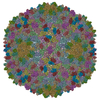
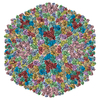
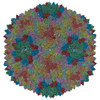
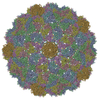
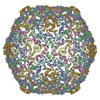

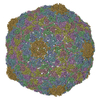
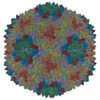
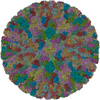

 PDBj
PDBj
